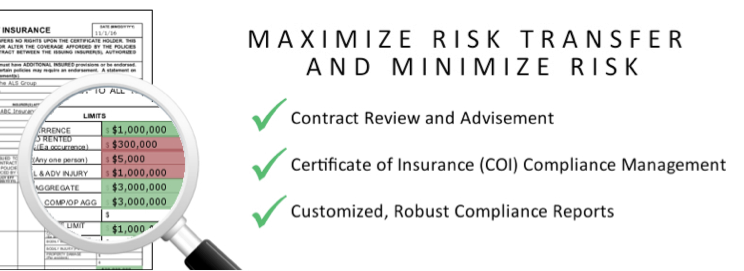
Errors and even outright fraud in certificates of insurance is a growing problem. We encounter a 70% noncompliance rate on initial documents.
The certificate of insurance compliance function protects a company by ensuring that its contractors have appropriate types and amounts of insurance coverage. The burden of this compliance process is often underestimated.
- The typical COI compliance staffs are strained by the volume and complexity of the work
- COI tracking systems often do not adequately accommodate the variations and ad hoc items nor the iterative communication process
- The staff itself may not include individuals with the appropriate insurance and industry experience
- Staffing efforts may be partially undermined if there are no up-to-date, written procedures to facilitate expansion and back-filling of the staff
Weaknesses like these may cause the compliance staff to fall behind in vetting COIs and related documents.
Real estate developers, general contractors, property owners, franchisers, manufacturers, and shipping companies are particularly vulnerable to developing a backlog in vetting COIs and related documents because they have to collect them from a multitude of providers such as cleaning and maintenance vendors, raw materials suppliers, subcontractors or commercial tenants.
The backlog may be so daunting that the staff relies on examining only the COIs and foregoing the collection and examination of the related documents: the endorsements, the declarations page and the schedule of forms and endorsements (colloquially known as the “forms listing”).
COIs are not the insurance policies and they are not enforceable. It is the endorsements, not the COIs, that unambiguously confirm satisfaction of such requirements as additional insured status, waiver of subrogation, primary and noncontributory terms and notice of cancellation. In addition, the declarations pages and the schedules of forms and endorsements will indicate if there are special and restrictive provisions to be evaluated. For example, a contractor may have opted to be “self-insured” to an extent that may be problematic.

The four-pronged approach to overcoming the challenges of certificates of insurance compliance involves ensuring that:
- The COI compliance staff has the right experience and knowledge
- The tracking system accommodates varying coverages, limits, wording and ad hoc items
- The tracking system accommodates the iterative communications and can provide up-to-the-minute compliance status on demand and
- COI compliance procedures are complete and current so that back-filling and staff augmentation are not saddled with a steep learning curve
Is your vendor compliance function adequate? Need help with your vendor insurance compliance program? Not sure where to start?
{{cta(’99a5d434-041d-4fcf-8d5e-3fd51a50c305′)}}


